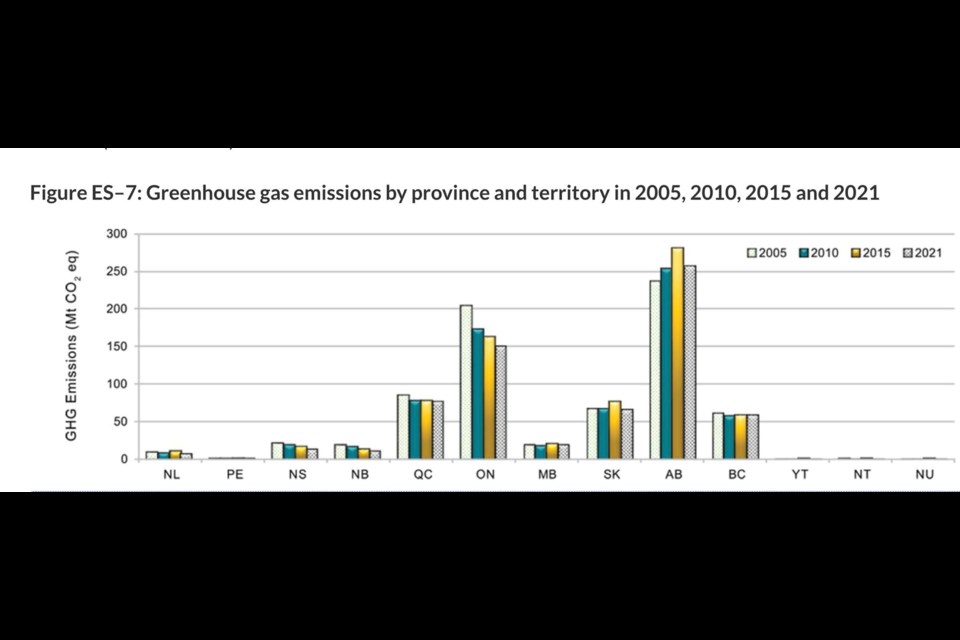A Canada-wide report on greenhouse gas emissions released last week showed Alberta’s GHG emissions had increased compared to Canada-wide numbers.
“Alberta is an outlier as emissions have increased more since 2005 than any other any other province,” said Simon Dyer, deputy executive director from the Pembina Institute.
On April 14, the federal government released the National Inventory report 1990-2021: Greenhouse Gas Sources and Sinks in Canada. The report found that, overall GHG’s in Canada had dropped since 2005, but GHG emissions in Alberta had increased by 8.6 per cent.
Dyer said he wasn’t surprised by the numbers out of Alberta because at the time of the interview, the province had no climate plan in place.
“Alberta has not made a commitment to reduce emissions either by 2030 or by 2050. We’re one of the few jurisdictions that hasn't made a commitment to net zero emissions by 2050,” he said in an interview on April 14.
On April 19, the province released a climate action plan with “net-zero aspirations by 2050.”
In a statement, Dyer was critical of the lack of commitment on reducing emissions in the short-term.
“There is no 2030 target. Lack of a near-term target without a clear emissions reduction signal could lead to decisions that lock in higher emissions, such as building natural-gas fired power plants to produce electricity instead of investing in renewable energy, battery storage and better transmission inter-ties with neighbouring provinces,” he said in the statement.
Canada’s GHG emissions were 670 megatonnes of carbon dioxide equivalent (Mt C02 eq) in 2021, according to the report.
Data from the report showed overall, Canada’s GHG emissions had decreased 8.4 per cent or 62 Mt from 2005 but had a slight increase of 1.8 per cent or 12 Mt from 2020. Despite the increase in GHG from 2020, emissions remained 7.4 per cent or 53 Mt below 2019 emission levels.
The report broke emission numbers down by economic sectors including oil and gas, electricity, transport, heavy industry, buildings, agriculture, and waste and others.
According to the report, the oil and gas and transportation sectors were the highest GHG emitters in 2021. Data showed the transport subsector had an increase of 9.0 Mt or five per cent, and the oil and gas extraction category had an increase of 4.0 Mt or four per cent and were the major contributors to overall increases in 2020 and 2021.
The report named expansion of the oil and gas sector as the primary reason for the increased emissions in Alberta.
Dyer said they are urging this or the future Government of Alberta to catch up with the mainstream on this issue and “to take responsibility for regulating the oil and gas industry.”
“Alberta doesn't have a climate plan and hasn't made a commitment to reduce emissions investors are noticing. It's a liability to our economy tend not to be seen as a place that has stable, clear rules about reducing emissions,” he said.
However, Alberta does have some success stories, said Dyer.
“The emissions reductions associated with Alberta moving away from coal fired power — that's quite significant. Obviously, that started under a previous government, but you've seen industry really start to accelerate the coal phase out. That's very good news,” he said.
Another success, Dyer explained, is the reduction in methane emissions with improvements associated with oil and gas extraction.
“But the general trend is just expansion of the industry. It is occurring at a faster rate than any improvements,” he said.
Neither the Canadian Association of Petroleum Producers (CAPP) nor the Alberta Environment Ministry responded to requests for comment on the National Inventory Report..
Dyer said the issue is urgent for all jurisdictions in the country and it is a shared responsibility of all levels of government.
According to the report “Canada accounts for approximately 1.6 per cent of global GHG emissions” and is the tenth largest emitter and one of the highest per capita emitters.
Dyer said Alberta is not pulling its weight as part of Confederation in terms of addressing the issue of GHGs.
“I think the key message is that Alberta really needs to show up as part of the solution. We’re the biggest source of emissions in the country, so we are the biggest potential source of the solution,” he said.
The report is submitted annually around April 15 to the United Nations Framework Convention on Climate Change UNFCCC, an international treaty established in 1992. The objective of the UNFCCC is to stabilize atmospheric GHG concentrations to prevent dangerous changes to the climate system, according to the report.




